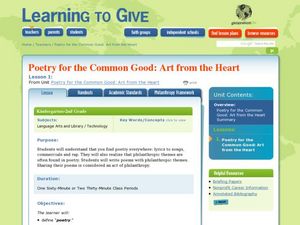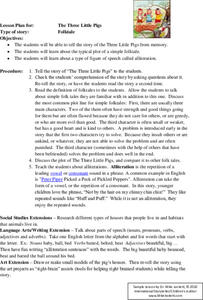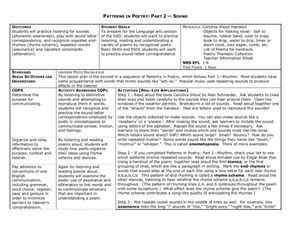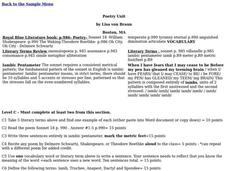Curated OER
A Little Alliteration
Second graders study rhythm, rhyme, and alliteration in poetry by completing various activities. In this language arts lesson, 2nd graders practice recognizing alliteration and then create their own poem using alliteration.
Curated OER
Alliterations Allowed
Fourth graders recognize and create alliterative language in both literary and commercial use. In this language arts lesson, 4th graders analyze pieces of poetry and focus on the use of imagery, personification, and figures of speech.
Curated OER
Sound Devices in Poetry, Fiction and Nonfiction
Students examine the impact of sound devices in poetry. In this poetry lesson, students read the listed poems and identify uses of alliteration, repetition, consonance, rhythm, rhyme, and slang. Students discuss how sound devices enhance...
Curated OER
Always Allow Alliteration (part 1)
Students identify letters and sound that are being alliterated in a text they are given. In this alliteration worksheet, students also create alliteration in words and sentences.
Curated OER
Lots of Lessons from Aesop
Aesop’s Fables offer young learners an opportunity to study figurative language. After reviewing theme, simile, alliteration, and metaphor, model for your pupils how to identify examples of these devices in the fable. Class members then...
Curated OER
Poetic Devices
Introduce middle schoolers to poetic devices with a lesson that asks them to find examples of alliteration, anaphora, onomatopoeia, metaphors, similes, and personification in various poems. Young scholars craft examples of these poetic...
Curated OER
Poetry: Ten Little Schoolchildren
Students analyze a sequential, story poem and put the stanzas in order. They identify repeated verses and answer questions about the poem. They identify examples of alliteration. Finally, they make their own poem in a given pattern.
Curated OER
Poetry for the Common Good
Students identify examples of philanthropy in poetry or song. In this philanthropy lesson, students examine several poems such as Give by Carrie A. Thomas and identify concepts of philanthropy in the poem. Students construct their own...
Curated OER
Connecting Poetry with Philanthropy
Young scholars use their knowledge of philanthropy and poetic conventions to write original poetry about philanthropic giving. In this philanthropy lesson, students write poetry based on philanthropy using poetic conventions. Young...
Curated OER
Poetry: Using Prosodic Devices
Students examine poetry examples in free verse focusing on their prosodic elements. After critiquing works by several authors, they write their own poems utilizing such devices as alliteration, repetition, rhyme, and stanzas.
Curated OER
Alliteration
Students write and illustrate a sentence which names a letter of the alphabet. The sentence should have subject, verb, describing words, and incorporate alliterative techniques.
Curated OER
A Little Alliteration
For this poetry lesson plan, young scholars listen to stories that contain alliteration. While listening to stories, student pairs make a list of words that they then use to construct "silly sentences" that contain alliteration. Each...
Curated OER
Pictures in Words: Poems of Tennyson and Noyes
Eleventh graders describe and analyze the effects of poetry on readers. They participate in an Internet scavenger hunt, an exercise involving interpretation of poetry through visual art, and an opportunity for students to create their...
Curated OER
Teaching Poetic Devices
High schoolers identify and analyze the poetic devices of alliteration, metaphors, onomatopoeia, personification, rhyme, and similes. They identify examples of each poetic device in songs, complete a worksheet, and teach the devices to...
Curated OER
The Nature of Haiku Poetry
Students brainstorm elements of nature art prints and photos. They identify the syllable count of Haiku and take a nature walk. They write Haiku poems while practicing the use of simile, alliteration, metaphor, and analogy to describe...
Curated OER
Language Arts: Creative Writing Devices
Eighth graders review sound and rhythm devices and apply them to their own writing exercises. Next, they interpret the poem, "Where I'm From," as an example of a personal narrative. Using their understanding of poetic devices, they...
Curated OER
The Three Little Pigs
Young scholars read the story The Three Little Pigs and complete language activities about them. In this The Three Little Pigs lesson plan, students research houses, draw houses, and write alliteration poems.
Curated OER
The Power of Poetry
Students utilize the Internet to research figures of speech used in poetry and poetry terms
Curated OER
Poetry Sings
Students examine examples of literary terms in poetry. Then they choose two songs, write out the lyrics, and decipher what they think the artist is trying to say. Each student presents their song to the class and they cite examples of...
Curated OER
Poetry: Serve Warmly and More Often
Pupils identify the mood and theme associated with the language of poetry. They discuss personal interpretation in small groups, and as a class and * experiment with language and rhythm.
Curated OER
The Elements of Poetry
Ninth graders explore the elements in poetry. In groups, they complete a jigsaw puzzle and discover the strategies for completing a puzzle and reading a poem are similar. Students read short poems and identify key elements in a poem...
Curated OER
Patterns in Poetry: Part 2 -- Sound
Students understand a variety of poems listening for sound letter correspondence, rhyme scheme, assonance, and alliteration. In this language arts lesson, students practice listening and reading skills to complete patterns in poetry. ...
Curated OER
Poetry Unit
Students, after examining three forms of poetry, review and document a variety of literary terms. Vocabulary words are enveloped into the literary terms as well and are cited from each selection by each student.
Curated OER
Over the River and Through the Woods:Prepositional Poetry
Fifth graders will be able to identify and use prepositions correctly in written work.¿¿¿ They will also be able to identify poetic devices.They will see how their writing can be more descriptive and "visual" for their audience.

























